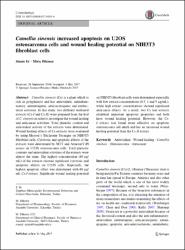Camellia sinensis increased apoptosis on U2OS osteosarcoma cells and wound healing potential on NIH3T3 fibroblast cells
Abstract
Camellia sinensis (Cs) is a plant which is rich in polyphenols and has antioxidant, antiinflammatory, antimutagenic, anticarcinogenic and antibacterial activities. In this study, two different methanol extracts (Cs-I and Cs-II) were prepared from the leaf of C. sinensis in order to investigate the wound healing and anticancer activities. Total phenolic content and antioxidant activity of the extracts were determined. Wound healing effects of Cs extracts were evaluated by using Masson's Trichrome Tecnique on NIH3T3 fibroblast cells. Cytotoxic and apoptotic effects of the extracts were determined by MTT and AnnexinV-PI assays on U2OS osteosarcoma cells. Total phenolic contents and antioxidant activities of the extracts were almost the same. The highest concentration (60 A mu g/mL) of the extracts showed significant cytotoxic and apoptotic effects on U2OS cells. Especially, the highest apoptotic effect was determined with 60 A mu g/mL Cs-I extract. Significant wound healing potential on NIH3T3 fibroblast cells were determined especially with low extract concentrations (0.5, 1 and 5 A mu g/mL), while high extract concentrations showed significant anticancer effects. As a result, two Cs leaf extracts exhibited important apoptotic properties and both have wound healing potential. However, the Cs-I extract was found more effective on apoptotic osteosarcoma cell death and has an increased wound healing potential than the Cs-II extract.


















